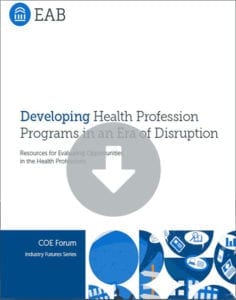Developing Health Profession Programs in an Era of Disruption
This toolkit accompanies our study Health Professions: Capitalizing on Creative Disruption. The study pinpoints long-term academic program opportunities in the health professions—also known as allied health professions—for COE units. The resulting Health Professions Growth Portfolio consists of the following programs: Health Informatics, Clinical Mental Health Counseling, Social Work, and Physical Therapy and Occupational Therapy.
This toolkit is designed for deans and program directors to help assess the opportunities in the growth portfolio. The toolkit’s resources are based on EAB research and interviews with deans and program directors of health professions programs. While the toolkit focuses on opportunities in the programs listed below, the program opportunity evaluations may be applied to a wide range of health care programs.
Health Informatics
Health informatics is a key part of a COE health care portfolio, but existing programsneed to evolve alongside an industry-wide push for new accreditation standards and professionalcertifications. Health care has expanding data integration, system interoperability, andreporting needs that informaticists are well-positioned to serve. The proliferation of healthinformatics programs, the lack of common standards due to the absence of accreditationrequirements, and employer confusion over graduates’ skill sets prompted standardizationinitiatives. CAHIIM, the accrediting body, is adopting new competency based standards and thetwo professional associations have introduced new informatics professional certifications.
- Meeting Curricular Standards
- Aligning with Professional Certification Standards
- Launching a Health Informatics Program
Mental Health Counseling
Bipartisan health care legislationhas increased access to mental health care. The resulting demand for mental health counselorsmay be served by two degree programs: the Master of Clinical Mental Health Counseling andthe Master of Social Work. Both programs are viable options, but different curricula andaccreditation requirements can make one program a better fit for your institution.
- Counseling Program Opportunity Evaluation Guide
- Counseling Program Accreditation Analysis
- Clinical Mental Health Counseling Programs by State
- Master of Social Work Programs by State
Physical Therapy and Occupational Therapy
For those that can overcome the barriersto launching either physical or occupational therapy programs, high returns are likely. There is a dramatic shortage ofphysical therapists and occupational therapists, with at least 15 job postings per new graduate.Programs are net revenue generators, with high tuition and more than 100 required credits.However, the supply gap persists because launching a program and meeting robustaccreditation standards can incur start-up costs between $1 and $4 million.
- Therapy Program Opportunity Evaluation Guide
- Therapy Program Accreditation Analysis
- Physical Therapy Program Map
- Occupational Therapy Program Map
As the health care market shifts, capitalize on creative disruption
The Health Professions study analyzes COE units’ long-term program opportunities in growing health professions fields. Download the study.
This resource requires EAB partnership access to view.
Access the tool
Learn how you can get access to this resource as well as hands-on support from our experts through Professional and Adult Education Advisory Services.
Learn More